An Excerpt from Shemitta - For the Land Is Mine
Copyright 2009, by Mark Edward Vande Pol All rights reserved
To some if not most readers, the Biblical observations in this book about native habitat may seem more like romantically stretched religiosity rather than tangible, much less empirically measurable science. So, even with all the correlation presented in this work, why should you believe that I am some kind of expert when I am neither famous nor have I prestigious credentials? Well, perhaps this story of our personal effort to save a little piece of California will help with the technical background with which to appreciate the depth of personal experience behind what has been discussed (if you wish to add hard economic analysis to that technical picture, take a shot at Natural Process).
If you have not read the picture book The Wildergarten or if you need a review, now is a good time, as it will help you appreciate what it is going to take to fix this mess and how badly we need professional habitat management in the private sector. The purpose of this discussion is to impart how important it is for YOU to learn to improve the total productivity of the land around you. It is important to learn how to best optimize the interplay of human use integrated with native habitat, no matter how small or urban your property may be. Conversely, preservation of open land, whether precluding people from living on it or preventing them from working it in the name of “saving” it, can be a horribly destructive thing to do. That should be enough eco-blasphemy to get us started.
Our property is almost uniquely blessed for a place this small. It is home to five distinct types of habitat: redwood conifer forest, oak and madrone woodland, native meadows of several types, chaparral, and the unique “Santa Cruz Sand Hill” habitat (the only thing we’re missing is a pond or running stream). All told, we now manage 392 plant species (an almost unheard of degree of “species richness” for a parcel this small) of which 253 are native. According to at least seven local botanists and restoration experts (three of whom had been presidents of the Northern California Chapter of the California Native Plant Society) our property now has the most purely native systems of plants to be found anywhere on the Central Coast of California; there is no park, preserve, or “pristine area” to be found anywhere in the region that is not significantly infested with exotic plants by comparison. This achievement has demanded a huge investment of time, money and labor that is not over by any means.
Land restoration is an all-consuming multidisciplinary occupation, sometimes as much engineering as it is biology. Most of what little restoration has been attempted has been confined to very expensive government or corporate-funded projects, most of which show debatable results.
As to credentials, we started this work before formal classes in “restoration ecology” were offered to the general public; nor did I later have the time or inclination for such an education once they were. As things are now, teachers have been bringing their students to our land to see what can be accomplished – and leave blown away. You see, with the billions of dollars tax-payers are spending on “restoring Nature” in California, there is only one (1) place in this region that has been returned to native vegetation down to the small forbs, and it hasn’t cost you a dime. That place is the Wildergarten.

Santa Cruz County, California
The Santa Cruz Mountains are on the north end of the Central Coast of California, extending from San Francisco southward to the Pajaro River emptying into central Monterey Bay (See map at left). This region is both geologically and climatically similar to parts of Israel: densely faulted hills parallel to the ocean. Soil types can change within a few feet, from crumbly sandstone, to clay, to shale, or even decomposed granite. The steep canyon walls receive a range of sun and shade conditions depending upon orientation. The weather varies radically within a few miles. Like Israel, the climate is Mediterranean. Summers are almost entirely dry with temperatures varying 40°F the same day. Inland summer temperatures on a ridge often rise over 100°F, while a canyon 100' below can have a marine climate 10° cooler. The winters can produce anything from 8.5 to 125 inches of rain in five months, 30-50 inches being usual. Habitats include meadows, chaparral, forests, rivers, and an ocean interface with beaches, sand dunes, rocky tide pools, and estuaries.
This region is one of the great biodiversity reserves of the world, with unique overlays of habitat types within very short distances. The North Coast redwood type ends at the southern tip of the range, while the Central Coast ecotype terminates in San Francisco (there are redwoods in Big Sur, but that is a small and isolated outlier). There is even an island of Sierra Nevada species centered in Scotts Valley, not far from our place. The favorable weather conditions and its long history of resource extraction, agricultural settlement, abandonment, and residential development has resulted in a long series of infestations of exotic plants and animals. Our property alone once hosted over 110 exotic plant species. The situation in the region is far more damaged than is commonly understood and it is rapidly getting worse.
Plants are the most accessible means for people to manipulate the natural world. They have few defenses, tend to stay put, and are relatively easy to propagate. Besides providing the bulk of food and habitat for people and land animals, they provide nutrient and structure for rivers that feed the estuaries that breed so much life in the ocean. Learn to manipulate plants and one can indeed hold sway over every bird of the air, fish of the water, and insect crawling on the earth… for better or for worse.
Native plants are like the foundation of a house. Insects need them for food and breeding while the plants need the bugs for pollination. Among pollinators, native bees are by far the most effective while European honeybees are in trouble. Most bee species are solitary, not social (including all 1600 species of native California bees). They do not make honey to store food but consume nectar and pollen, thus requiring flowers in bloom all year (except for winter when they are in the larval and pupa stages). Native bees vastly prefer native plants; they visit 80% of the natives, as opposed to only 9% of non-native plants (Frankie 2005). So, without native plants, all plants that require insect pollination, including agricultural, do not set fruit efficiently. Exotic annual plants that comprise most invasive weeds are almost all self-pollinating. If people allow exotic weeds to propagate such that they interrupt the production of native plant pollen over the summer, they lose pollinating bees, thus placing food production at risk. If they allow weeds to propagate over a sufficient area across the path of migratory animals requiring fruit (especially birds), the animals then lack food for the trip. So it goes right up the food chain.
Exotic plants are displacing native plants worldwide. Together with plant succession, we are losing native annuals, especially wildflowers. One third of the extinctions in the US to date are solely because of introduced species; no one has even begun to account the number of species lost to “preservation” (any scientist who tried to get such a grant can look forward to a short career). The longer we allow non-native plants to take over, the more we preclude disturbance by “preservation,” and the more dense urban development excludes native plants, the more native seeds lose viability in the soil. We are thus slowly losing the genetic building blocks to rebuild the system foundation. This is not to say that all introduced plants or urban development are evil. Far from it! It IS to say that humans must be careful when introducing new species into a system and control what they can and cannot do. We are to hold sway to bring fruitfulness to the earth, not to abandon our responsibilities to “Nature” because it is too much trouble. Natural Process).
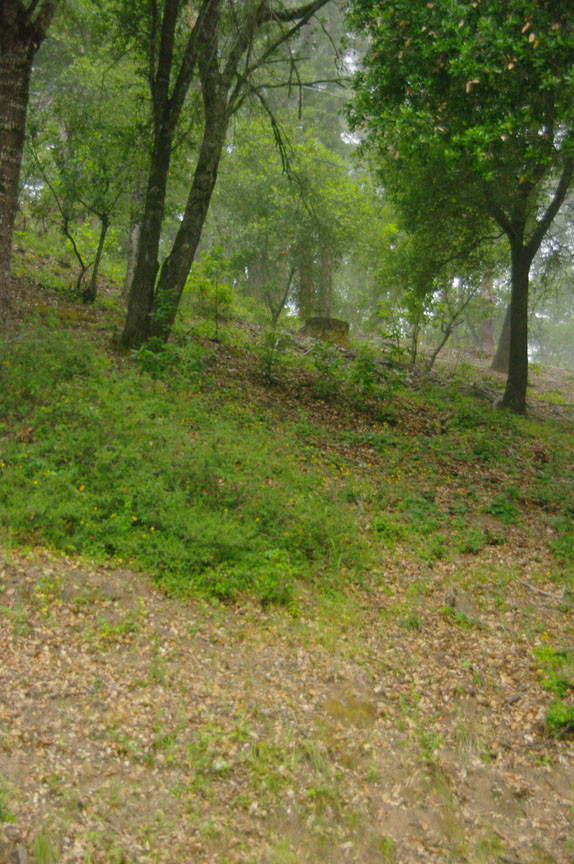
Orchard Terraces
In this photo, there are five
For over 34 years, out of what at this point could only be called dogged persistence or Pyrrhic sentimentality (a Pyrrhic victory is at devastating cost to the winning army), our family has been converting our mere 14 acres back to native plant habitat (the name “Wildergarten” was on our plot plan when we applied for a building permit). The property has endured a tumultuous botanical history. After the people who had run it for thousands of years the first big change was the Spanish extending a branch of the El Camino Real in 1791, running right past the front of the property along its entire length. Every ox, cow, horse, or sheep the Spanish brought by, left its contributions of whatever they were eating, a process that continued for over a century. They even planted an olive tree here, probably just for shade. The next big thing was Governor Joaquine de Arrillaga's ban on Indian burning in 1793. That allowed brush and trees to begin to escape those areas where regular fire had confined them for thousands of years. They too extended a "native" seed bank that persists to this day. This doesn't make it inherently a "bad" thing, but it did have its impacts, particularly for insects and wildlife. Native Americans ran a system primarily based upon annual plants and bulbs. Banning burning built a system based upon perennials.
The most common land use in the region was was for cattle, but at the time this place was too remote even for that. The next big change came after Americans arrived when the first road was “built” alongside it in 1863. During its first seventy years thereafter, this road was one of the principal transportation routes across these mountains between the Santa Clara Valley and the growing city of Santa Cruz. Every horse in the region deposited their contributions of seed from the valleys below, native or not, and found a thoroughly disturbed location in which exotics could establish, drop see, and were tilled in every year.
The valley below us became the resort town of Glenwood, which at its height it boasted three hotels, a swimming pool, a conference center, and 500 permanent residents. The owner needed access, so he built another road past our place up to the "main highway" along its length. This place was used for manufacturing moldings, cattle grazing, harness repair, an apple orchard (the eroded terraces and trashed equipment are still visible), which became the most popular land use until the railroad came into the valley below, making orcharing on flatter ground farther from cities more profitable than those up here. For decades, Ed Fenn enjoyed that access road after the first train came through the valley below to carry his apples to market. Every year, he kept tilling and the weeds just kept right on multiplying and spreading. Somewhere about 1935, the orchard was abandoned. By the time we bought it in 1989, all but one of the orchard trees had died.
Building roads brought other massive changes. The biggest was that because they were dirt, they had to be graded so that the water from winter rains was collected in inside ditches; else wagons could not traverse them unless completely dry. The roads collected all the runoff along ridges and that runoff had to go somewhere, and that was usually at corners. One of those was on the southern end of the property, the outfall from which took out 30-40,000 cubic yards of alluvial soils deposited from the ridges above. Today I call it, "Spanish Gulch."
Unknown to just about everybody, the area was being invaded by a native plant: Quercus parvula shrevei, a form of interior live oak. The acorns were dragged up here by horse-drawn road grading equipment and deposited in side castings, but as long as the properties below the road were disturbed on a continuous basis, those "tree-lined" roads remained the limit of that invasion. Redwood too had established in gullies. Logging them between 1880 and 1890 created whole new stands of single-aged trees where there originally had been at most three. As forests propagated, late-season water availability for fish declined.
The resort below us became more than just a popular tourist spot. The existence of that train all the way up to Alameda meant that a botanist from UC Berkeley could be in the Santa Cruz Mountains in only two hours. So they did, between 1890 and 1941, Glenwood became well known in academic circles for its amazing residual biodiversity. That archival botanical record became critical to our management decisions today.
For a time the place had been fenced and grazed until a dispute befell the neighbors. Then a weird form of parallel succession took over, and progressed unimpeded for decades. Because the land had been tilled and cattle grazed on it, everything took off at once without the constraint of fire. The brush species were ceanothus and manzanita. Among them were oak and madrone trees, but in unprecedented density . Once through the brush, the trees bolted for light, many only a few feet apart as spindly, weak, leaning trees with included bark crotches. With them came the fir, which shot upward retaining massive dying branches all the way to the ground.
The owners wanted to sell it. So from time to time they cleared a “house site” on the top of the hill (with a view of a power pole and not much else). In one off these instances some time around 1960 someone probably brought in a dirty bulldozer contaminated with French broom. It took off and spread each time the dozer came in. By the time we bought it, much of the property was virtually inaccessible, even on foot. The broadleaf forest was choked with a multi-layered mass of dying fuel so thick I had to crawl to get around leaving survey tape tied to shrubs to find my way out (I was within twenty feet of a county road and didn’t know it until I heard a car). The native chaparral was standing, but long dead. Many scraggly trees were dying. The groundcovers were virtually gone. I tried to take pictures, but other than the areas cleared to sell it, there would be nothing to photograph but wads of branches. It had multiplied all right, but it was not in any way flourishing.
When we started clearing, the place was almost entirely forested, with only 60 active plant species, and perhaps twice as many more as seed lying dormant in the soil (mostly weeds). However, those numbers understate the problem in terms of producing populations. If one only counts the species with substantial presence in their niches (as opposed to a few isolated individuals), the total number of species falls to about 20. More importantly, from that Glenwood botanical record, we now know that over 80% of native plant biodiversity was no longer reproducing. This was a mass extinction event in process proceeding sight unseen. The causes were exotic invasion AND uninterrupted succession, exactly what is produced by a policy of "environmental preservation."
So the first order of business for me was thinning the fuel before it blew up into a total catastrophe. There were several stands of exotic acacia and eucalyptus. Half a dozen of the latter were four-foot diameter monsters. The steep hillsides below where one might build a home had substantially succeeded to acacia, fir and bay, all of which burn like crazy. Just clearing around the eventual house site generated the equivalent of thirty dump trucks of cut tree tops and about 35 cords of firewood. We burned most of the trimmings. There were some truly spectacular fires that took a week for the coals to burn out (the fire captains of that time were more tolerant of such behavior; thank you Hank Epling and Mike Biddle). It is a process that continues, albeit on a much smaller scale.
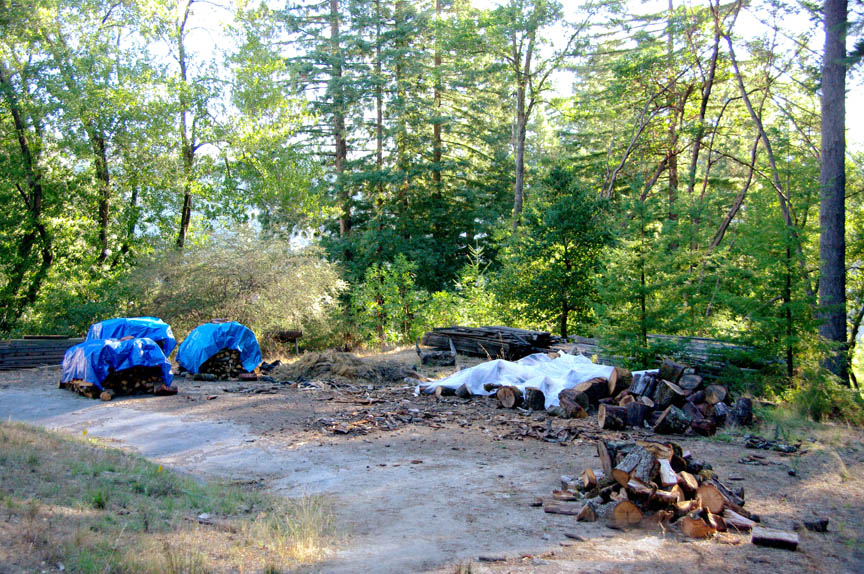
Our Annual Firewood Haul
Every year I remove an average of 5-10 cords of firewood and give away all but 2 (the State of California won’t let us sell it without a Timber Harvest Permit that can cost $60,000 for the paperwork). So I developed a process for making charcoal (aka "biochar") to see if we can derive the same benefits Amazonian tribes did with terra preta.
The total mass of timber is growing much faster than we are removing it. There are fewer trees, but they’re getting bigger faster and there are many more healthy seedlings. Now, that might seem like a blessing, and it sometimes is. Most often however, these seedlings require thinning, frequently. It would sure be nice to just light it on fire, but there is just no way to control the consequences because of all the fuel in these mountains. The way the weeds would come up after a fire, it would be very difficult to get it back under control if the neighborhood blew up.
It would sure help if I could sell a few logs so that I could afford to pay people to thin my forest, but the State of California, at the behest of an urbanized group of activists, has made that option illegal. Note the difference in the picture book between stands I have logged and those I have not. One would think if that if they truly cared about the forest they should want it. I promise you, they do not. They care about their power to control, and won’t let go.
Removal of that much of the canopy brought forth both miracles and plagues. Predictably, what came back first were weeds. French Broom has been a particularly dominant shrub that grows 6-10 feet tall in 3-4 years (its roots have nitrogen-fixing bacterial nodes). One bush can produce thousands of seeds each year that can remain viable in the soil for nearly a century. The infestation here had been present for thirty years (it’s a lot of seed). Worse, about ten years prior to our hand-clearing, bulldozers had scraped off the main ridge spreading it everywhere, making several piles of dead broom, one sixty feet long. Once it was cleared, ten acres of broom came up so thick I counted 200 seedlings per square yard. Although we have had it under control here for at least fifteen years, whenever I expose a denuded forest understory to sunlight, light off a burn pile, or if a gopher piles up fresh soil, the seedlings come up like a carpet. After nearly 35 years, it’s still a lot of seed.
Broom was only the beginning. Once that receded, up came acres of rip-gut brome grass feeding off the nitrogen the broom had left behind. Cat’s ear is like a dandelion on steroids. It blew in from next door making patches so thick I thought the stems were grass. When their heads came out, from a distance the ground looked like it had snowed. Something (probably the garbage company) brought in catchweed bedstraw (Galium aparine), which makes mats of sticky tendrils so dense that we rolled it up in big balls with rakes while cutting roots with a bushwhacker. We took out 37 garbage bags of hedge parsley in one year alone. Italian thistle came in by both vectors (neighbors and the roadside mowers). Thistles are usually a disaster to productive land. They dry out the ground and kill their competition (Gerlach 2004). They also produce hormones that keep other plants from germinating. The resulting lack of groundcover accelerates erosion. Not only are thistles prolific, exclusive, and desiccating, the spines and toxins can combine to cause chronic injuries to grazing animals. Most thistles come from Central Asia, present day Iran, Turkistan, Azerbaijan, Uzbekistan, Kazakhstan… much of which is semi-arid desert. The great archaeological sites in the area attest to the fact that these were once rich and prosperous lands. One year I filled two garbage bags with just the heads of Italian thistle (they’re small for thistles, about 1X2cm).
Ecologists use the term “seed bank” to describe seed long-dormant in the soil. Most see it as hidden wealth in the ground, a wondrous source of life and recovery in response to a seeming catastrophe. The classic example is the bloom of wildflowers after a fire. Almost ten years after first exposing our meadows to light, with the exception of needle grass, native meadow groundcovers were hardly visible. As I started removing the exotics, they were replaced by other weeds so numerous and evenly distributed that there was no way they could have colonized that fast. Slowly it dawned on me: I wasn’t dealing with just the weeds that come in or annual reseeding; the bigger issue was the viable weed seed left in the ground from long ago.
Unfortunately for my dreams of a quick fix, reality was far more “weed bank” than seed bank. In fact, fire activates the weeds more than the natives, as anyone who has looked at what comes up around an old burn pile can see. So in order to re-establish the natives, we had to remove successive weed bank “accounts” like peeling layers of an onion. The only way to do that was to let them germinate and then kill a high enough percentage that we could achieve significant reductions from year to year. Given the number of seeds they produce, that usually requires removal efficiency in excess of 99.9%; else each weed produces so many seeds as to make the effort a waste of time (depending upon its ability to disperse). These layers included broom, filaree, catchfly, then hop clover, then filago, then chickweed… These days the biggies are scarlet pimpernel and Parisian bedstraw. Some can take years to deplete their seed sufficiently that the next layer can express itself. In other cases an unusual weather year can set a weed bank off. Too often, what you find out at “the bottom” is that there is not very much viable native seed left. What you get is bare dirt ready to be colonized by native seed imported by animal carriers.
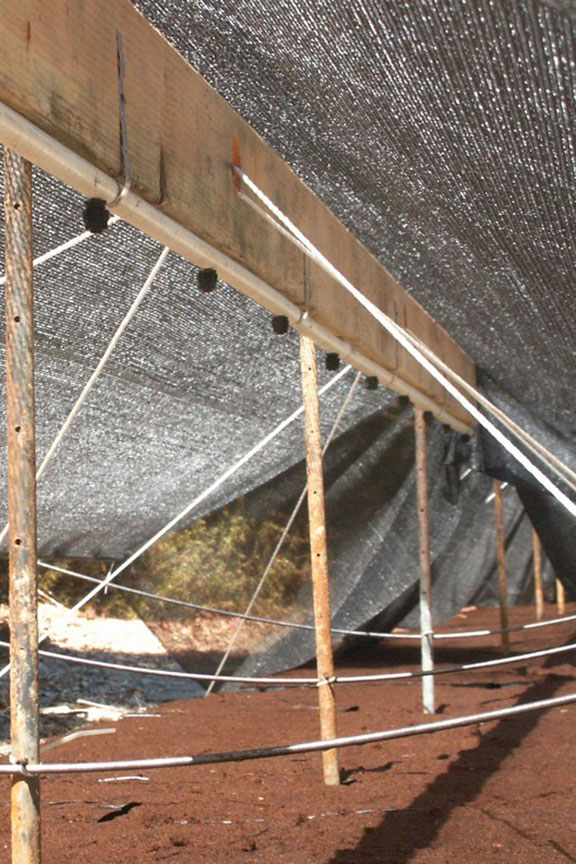
Plug Growing
It was a quick shade house, complete with irrigation. It worked great until the rabbits found the grass.
One can learn a lot about these plants by observing their colonization and dispersal processes, for where they first appear is not necessarily their optimal niche. The best confirmation of their preferences and behavior is from the cohorts with which they establish and the competitors they displace. It is obvious that there are chemical signals between their relatives because they become increasingly depauperate as they increase in density (Ludlow 2008). I suspect that population density also induces a similar response to chemical signals affecting the thickness of the seed coating and thus the eventual term of seed dormancy.
The reason the weeds come up so dominant is both physical and chemical. When a seed germinates, its roots exude hormones that inhibit germination of competitors; effectively “claiming” a patch of dirt (Zimdahl 2007). Species originating from regions with snow or desert are habituated to a short growing season, so they germinate and seed very rapidly. Native annuals in our fire-adapted Mediterranean climate wait until they are certain winter has come so that they don’t germinate after a freak summer rain just before the Indians burned off the landscape for the year. That the Indian regimen of frequent fire has been interrupted for so many years means the mayhem we have seen is a predictable outcome. That does not mean that fire is now a way to fix it.
As a result of their chemical dominance, after any disturbance over a large area (such as a wildfire), the weeds come in so numerous they can set seed way too fast to control by hand and can spread unimpeded over large distances. Our place is too steep for grazing animals or tilling. With the fuel densities on our neighbors’ properties, frequent fires such as the tribes once lit here are out of the question, even if there were not any houses. So, when the weeds come up acres at a time after removing others, or thinning the forest, we could only hose them with herbicides to control weed seedlings until they were few enough to control by other means: first spot spraying, then from squirt bottles, and then by hand. Do that for long, and managing one's hands for arthritis becomes a necessary part of the job.
Weeding also requires the ability to identify over a hundred weeds from over two hundred natives while still in their juvenile state (in tenths of a second in the case of spot-spraying, a mentally draining process). One cannot wait for seed on the plant to be sure what it is, because to delay that long leaves too little time to get them all. The attributes by which to distinguish seedlings are not in the flora books containing identification keys; those features must be derived by experience. For example, we have 54 species of grasses and sedges alone, of which just over half are native. Just within the Bromus genus alone there are serious differences among these grasses that are hard to distinguish in their juvenile states. Yet we must separate natives such as California brome (B. carinatus, a great forage grass and very palatable), tall brome (B. grandis, grows in forests; birds like the seed), or Columbia brome (B. vulgaris ditto) from exotics such as soft brome (B. hordeaceous, palatable but not a great forage producer), rescue grass (B. catharticus a host for plant pathogens), rip-gut brome, (a name applied to B. diandrus, B. commutatus, & B. sterilis, all of which we have had and all of which are true to the name when it comes to the mouths and guts of animals), and Spanish brome (B. madritensis, a lousy forage which has wrecked wildflower fields over most of Southern California). They appear under a huge number of visually variable conditions mixed with various cohorts. The process of making these life and death decisions is facilitated greatly by knowledge of what was living in each spot in prior years. So, not only is the job knowledge intensive in botany and horticulture, it demands excellent vision, detailed knowledge of the history of each spot, fast reflexes, strength (lugging a backpack sprayer on a 60° slope at the top of a small cliff), dexterity, and concentration. There is an end to it though. Contrary to popular opinion, it is not a treadmill. The problem is that most folks who spray do not follow up with hand work when the natives start to reappear.
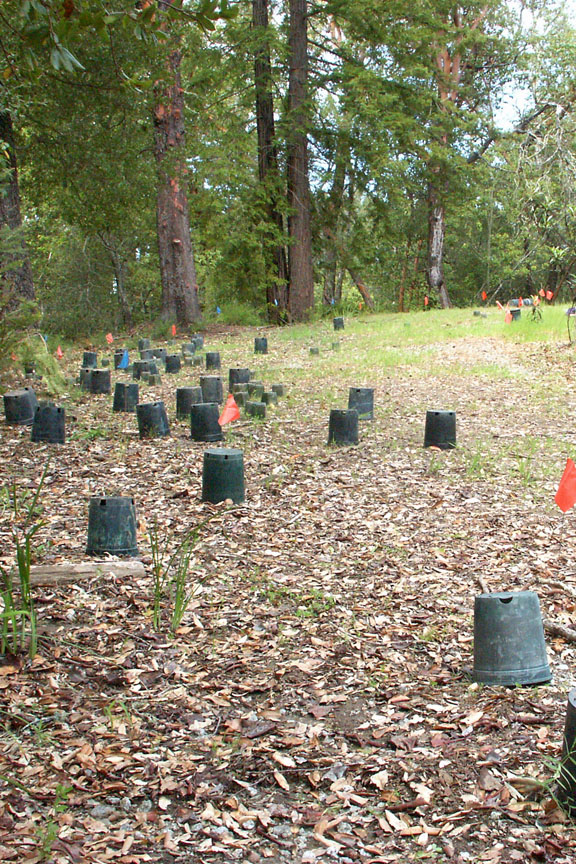
Masking for a Foliar Spray of Glyphosate
I've never had to do this process
more than twice
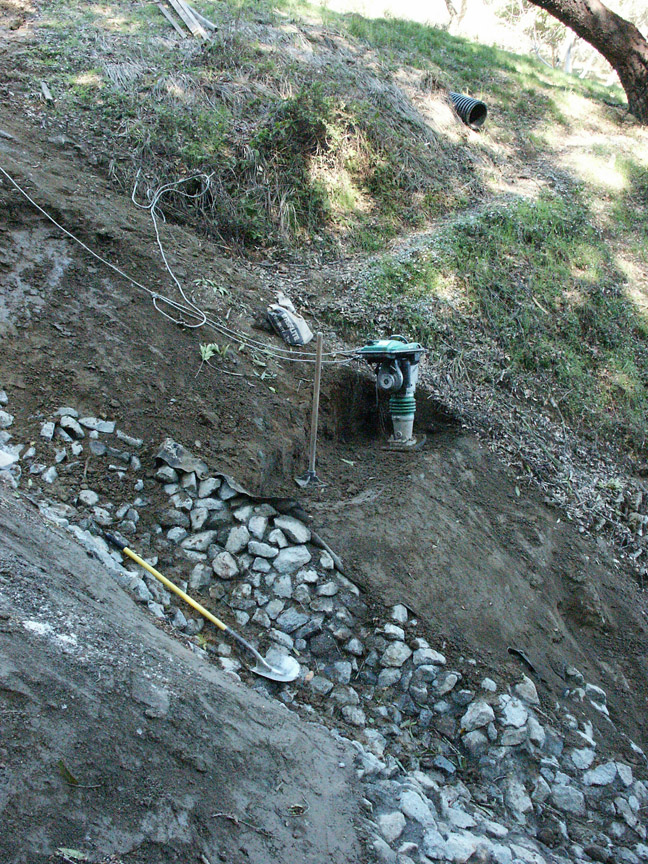
It's steeper than it looks in the photo
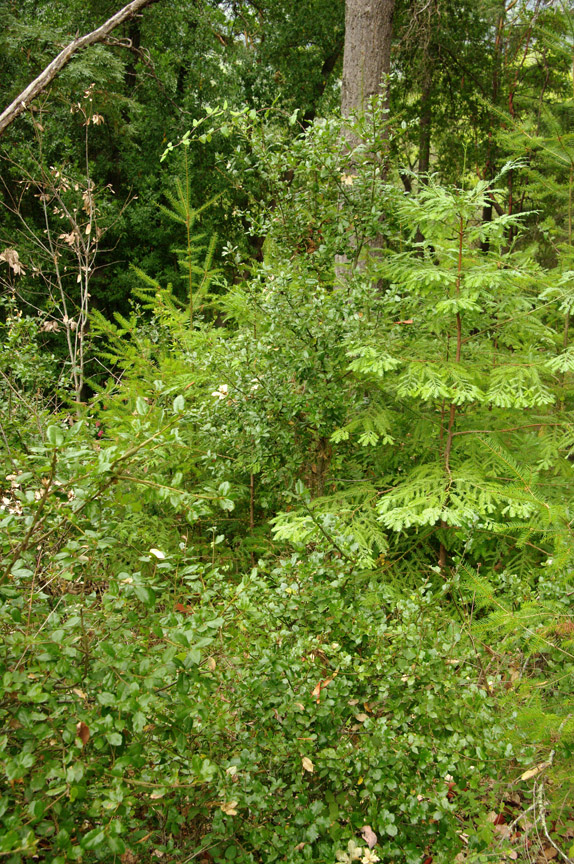
Twelve years ago, this was a road
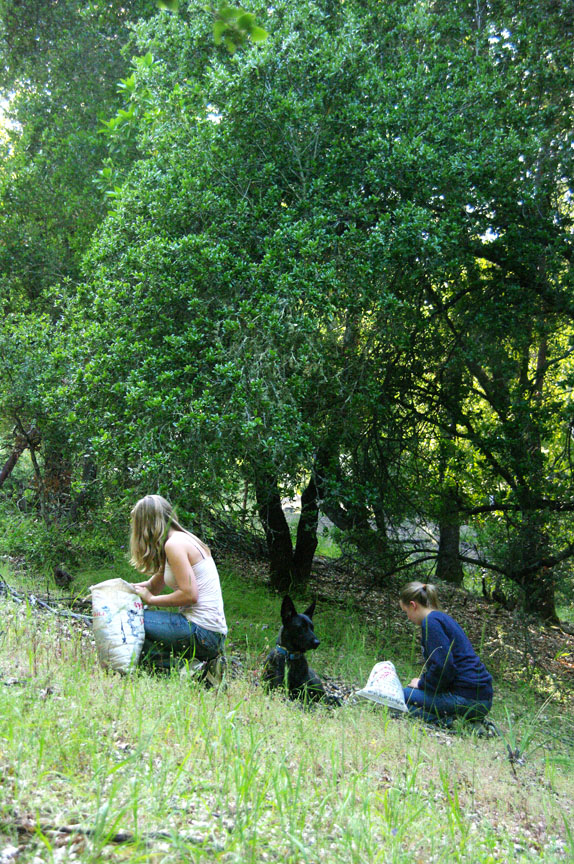
Family, Weeding
I was so proud of whom these two young people had become, until ignorant uiversity psychology as imposed by their peers won them over. They were smart, sincere, patient, funny, sweet, and didn’t they tolerate evil. Hopefully, some day they'll learn their mistake.
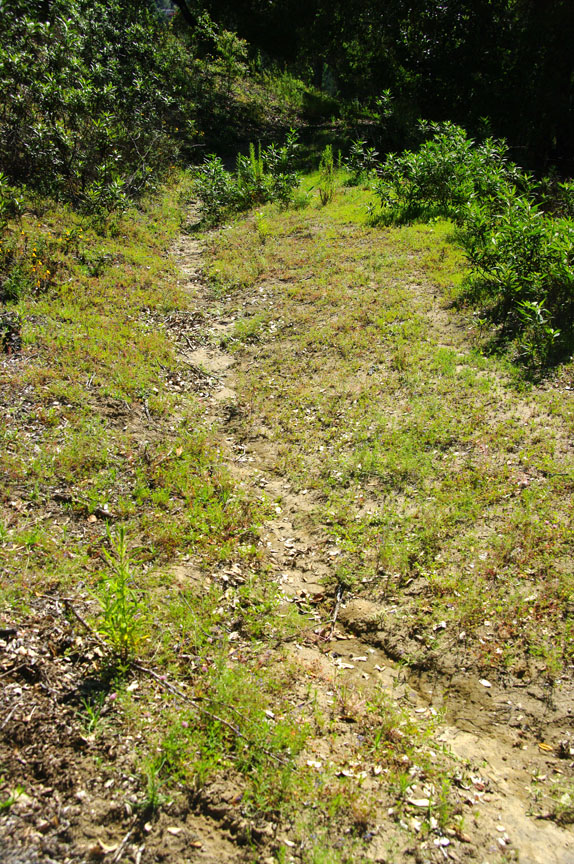
VICTORY!!!
It may not look like much, but this is proof that one really can clean a seed bank. This drainage at the bottom of our sand hill was scraped out with a loader two winters ago. After but one year of work, I was able to keep up with it by hand weeding alone. Now it is mostly native clover, Cammissonia, and Navarettia.
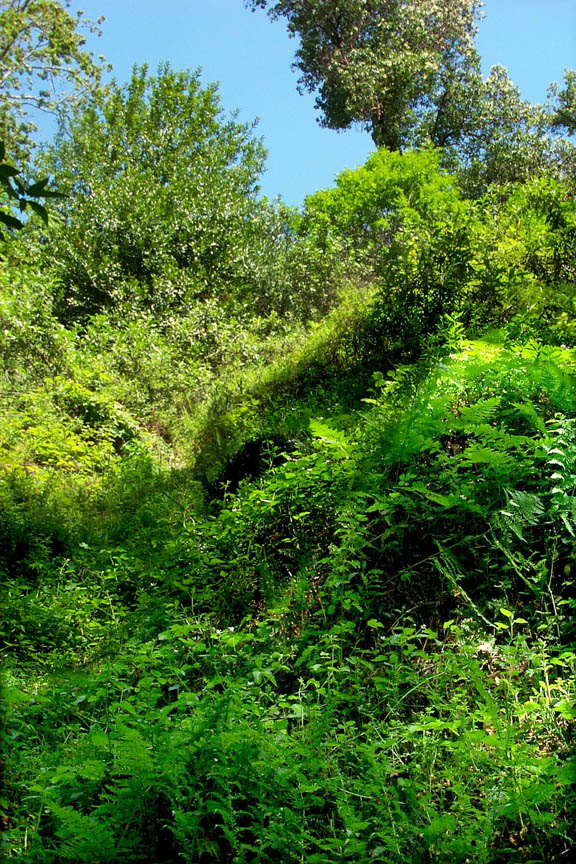
This Was a Mat of Fallen Acacia Trees
This is one instance where burning really worked. The acacia had formed a canopy over this gully. It was a monoculture, so dark there was nothing on the ground. It is VERY steep at the top with an 8’ vertical drop in the middle. I cut the trees, piled them in the gully, chopped them up into a pile 15’ wide X 8’deep X 80’long. It was a chimney aimed at my house. So, I called the fire department. They loaned me a hose, took my signature, and left. The coals burned for a week. Amazingly, only one acacia has ever sprouted here (it is a legume), the rest has been native, with the occasional infestation of bedstraw. I’ve since removed the bay trees.
Once the natives start to express themselves, we use a number of methods to separate them from the weeds. Most often, annual weeds appear soon after the first rain. It can be very effective to spray them in mid-winter when you get a few hours above 60°F because so many native annuals stay dormant while it is still cold. The special benefit is that sometimes you can remove multiple germinations of weed from the seed bank in a single year. That the process is both weather and time sensitive means that one needs proximity as well as extremely detailed knowledge of where the weeds are and what the solar aspect is on each spot to heat the soil enough for process efficacy. In other words, using herbicides to eliminate weeds is something so complex, requiring so much intimacy and site-specific knowledge, that only a person intimately familiar with the site can realistically do it.
As the natives come in, the mix of natives and exotics becomes too convoluted to broadcast spray. This is what we call “transitional habitat.” At some point in that transition, the conversion involves a LOT of hand labor that can go on for many hours a day on hands and knees. The management of one’s time under the circumstances is critical to keeping what you already have, never mind making progress, as weeds continue to invade from neighboring properties. To reduce the headaches of adding transitional habitat, one of the key things we have learned is to limit disturbance to what we can afford as a capital expense. Accordingly, removing too much overgrown forest must be considered carefully, because weeds will be first to reappear. However, if we do not make that transition, it will not help the forest; the trees will continue to be misshapen, spindly, and prone to disease until it blows up in a wildfire, nor will there be forbs for insects, their predators, birds, and many herbivores, nor will the native plants have a chance to replenish the seed bank. If there is a fire, the weeds will respond first over a huge area producing vast quantities of seed with few remaining barriers to their spread. Thus, this is about managing calculated risks amid wildly variable uncertainties.
There are also risks that are incalculable, but so severe that, once one is aware of them one is faced with the choice to go or or to quit. Such was the case of exotic Cardamine hirsuta. For at least 50 years, and for probably considerably longer, university botanists identified this species as native Cardamine oligosperma. When I first identifed the exotic here, it was not even in the flora books. The only alternative was to deem it the native. This is a very aggressive little pest of a plant, one that can germinate and pop seed in only six weeks. Even though it was nominally native, I hated it as very destructive to biodiversity, and therefore usually culled it. In 2014, the best botanist I knew and I agreed that it was probably exotic. He went on the warpath and found it to be true. I have since learned that it had been on this property for at least 50 years. How would you like to kill your precious native clover patches to purge that exotic after 14 years of detailed weed control? This is an economically significant weed in the nursery business. We still have not recovered fully, in part because of so many recent drought years. How would you feel about the competence and attention to detail in university botany? Nor was this the only error I encountered in the university botanical record.
Some of these weeds can be VERY small, but a quarter inch tall with seed on top. At one time, I spent seven months, full time and more, just weeding on hands and knees. It takes its toll on the body. With mountain lions, coyotes, and wild boar around, and with near vertical cliffs to weed, it can be scary too. So, to those other requirements, add mental and physical stamina, because weeds and fuel are not the only problems. Then there's dog training to teach them to keep watch without getting into the weeds.
Then there is drainage. When our land was stripped for farming, they terraced the hillside. The terraces directed the water toward the middle of the drainage while much of the soil was tilled, thus exposing it to erosion. The resulting slurry cut deep gullies, some of which threatened to destabilize the whole hillside. So imagine moving ten yards of dirt per day with a shovel mixing it with cement with a roto-tiller, and compacting it into shape with a jumping-jack, packing the surface with a hand tamper, and then transplanting starts, all on a slope that rises twice as fast as it runs. Other channels were packed with structures of small logs that simply trap sediment over time. In some places we run the water down the spine of a ridge (the harder rock) until it gets far enough down that it is safe to discharge into a stream bed. In this fashion, down-cutting on this property has been completely halted and in many cases reversed.
Did I talk about the rigors of logging? How about retiring old roads and grading the half-mile of roads I needed in order to maintain access to r emove excess fuel? It isn’t cheap and the issues are complex.
The point is: If we are going to retain even the option of reconstructing large scale native systems, it will require networks of living native plants producing fresh seed in symbiosis with their specialized cohorts such as insects and soil microorganisms to make such work even possible. We are a very long way from knowing how to do it. We are even farther from possessing sufficient financial resources and infrastructure to attempt such a project at a landscape scale. Yet even maintaining such living genetic refugia is so demanding that each project will need a high degree of control with highly educated, physically capable, and committed individuals. Just putting genes in a freezer won’t cut it, because these systems are all about complex relationships among plants, insects, bacteria, and fungi that we do not even pretend to understand. Else, we can watch while we lose the foundations of our wildland systems, perhaps forever.
Such control demands a degree of isolation that cannot be total, simply because these systems need to have their customary weather and the influences of migratory animals to stay alive. On the other hand, the method proposed by the UN and the Wildlands Project (connecting wildland “core areas” by a network of “corridors”) is, in my opinion, destined to be an absolute disaster; it will allow exotic plant infestations, pathogens, and pests to invade and establish the entire continent without restraint. For example, the very idea of precluding 'inbreeding' with such corridors fails to recognize that the very existence of thes supposedly distinct "species" such as dogs, coyotes, and wolves is dependent upon maintaining niche separation. Today we are breeding "coy-dogs" and "coy-wolves" without any idea of the consequences.
Not everybody can do this on a scale as big as our project and even fewer want to endure the hardship. “Why do you bother?” I am sure you have wondered. Many have warned me, “The greens might decide they want your land and get the bureaucrats to take it.” To that threat I possess a “Doomsday Response”: All I have to do is quit and it will be ruined in only two years. Without the knowledge of having worked it for decades, this land dies.
All my life, I have deeply loved what we have in California. Between high-density development, and weeds taking over abandoned ranches and farms, with parks otherwise choking with vegetation, that California is disappearing before my eyes. With all the wailing we hear from environmentalists, with all the billions of tax dollars they have spent, and with the horrible injustices and corruption they have foisted on landowners who have loved their property for generations… this may come as a surprise to you… but even after all that money, a detailed restoration project this complete has never before been attempted. I was just as shocked and dismayed as anyone to learn that, as I would have loved to have had a real mentor. Unfortunately, between ethnobotany, archaeology, pollen studies, and historical journals, we have only a very sketchy idea of how native plant systems might have once worked, and an even more rudimentary understanding of how to optimize the relationship between humans and the land. I am scientifically curious as to how best to interweave human production (farming, timber, ranching, industrial infrastructure, and residential) with wildland attributes as a way to bootstrap an industry in land stewardship. I also want to do my small part to take this country back from the arrogant stupidity of a fascist oligarchy.
Then there are the downstream questions. Nobody knows how much land one person can restore just in terms of time, money, and labor. After getting control of the weed problem, we still do not know what maintenance native habitat requires to keep it at this level of purity under the rapidly increasing barrage of weeds. We still do not know the costs of containment of weed infestations adjoining cleaner landscapes. We do not know the best types of native habitat by which to maintain buffers against more infested areas.
Then there is the problem of methods and equipment development. Restoration tools are lousy because the market is in its infancy. Native plants can be tricky to propagate with economic yields. To get economically acceptable yields often requires carefully controlled conditions currently found only in a nursery. Unfortunately, the industrial nursery model has become a problem because native plants are often site specific varieties. Preventing contamination of local stock has become an issue and when they make a mistake it can be propagated over an enormous area. I am looking into developing portable automated nursery equipment so that the propagation can be done on site. Our property is a wonderful R&D lab to test these methods and tools, to learn which local plants are best for specific purposes, such as lining stream beds that cross dirt roads. We are developing ways of rebui lding eroded drainage channels and reducing flow concentration. We need better tools, from a simple pocket liner for weeds that is easy to dump to better weed bags, perhaps visual aids such as filtered lenses to facilitate detection. Do not even get me started on the need for better electronic metrology.
That’s why. By the grace of G_d, we are making progress, at least in terms of getting the pieces in place so that we can fool around with it a little and perhaps learn something. So, even though we are the only place around with this pure a native plant system, we are not “done” and hopefully never will be.
Praise His Name for such a wonderful opportunity.
No matter how miraculous the recovery might be, it is not long before discord sets in. Free of the dominant chemistry weeds put into the ground, the native plants take off and keep right on multiplying, right into each other. It is almost scary how fast they grow, even in a drought year. It does not matter what type of habitat it is, meadows, oak woodland, chaparral, sand hill habitat, or redwood forest, the need is the same: Without either a disturbance (such as fire) or physical removal, nature multiplies until either a dominant species excludes everything else or they deplete the nutrients in the soil, neither of which is good. Without someone or something to use the excess biomass, the trees, shrubs, and grasses choke out the herbaceous groundcovers and then each other until they explode in a catastrophic fire.
Adonai gave us life that multiplies. We have a job to do.
With all its satisfactions and pains, with the tremendous beauty tending for nature can produce, with the preservation of liberty secured by a free people focused upon the long-term health and productivity of all the attributes of their land, all I can tell you is that it seems to me that G_d created us to dress and keep His Creation. I beg you, if you have the energy, money, or inclination, please, do what you can to learn the joy of raising a family making nature ever more beautiful and productive as a glory to its Creator.
If you can, buy a piece of land, for it is an education with sophisticated demands and abounding satisfactions. If you can not afford to buy land or do not have that kind of energy, there are volunteer groups that do restoration work. A great many of the people who work in such groups are badly in need of the message that people are a source of health in the land. There is way too much focus upon scarcity, fear, and death in the world, particularly in the environmental movement. Faith in our Creator can begin to mend that mindset that starts in the willingness to put our backs and shoulders to the work. You will gain so much, I can not begin to describe. Please, it makes a great vacation and a great mission.
If you can’t do that, landowners are in desperate need of information systems. Collecting technical information into usable form really does help people learn how to perform the many disciplines land management requires, plant, bug, and bird identification, drainage, forest practices, pruning, etc. Compile historical records from your area so that its botanical history becomes more discernable. Better yet, test an array of soil patches to see what comes up as successive weed layers are removed, or document how many seeds each head or pod produces, the statistics of pods per plant, etc for each weed. It is a great science project extending over multiple years that can help root children to their community and make a contribution to the people doing the hand work. As to where or how to post the information, there are a number of good beginnings in larger States that should be replicated, such as CalFlora, CalPhotos, or The Nature Conservancy from which you can probably get the search engines. Because botanical information is necessarily regional, there is a huge amount of work to be done taking pictures of projects, good and bad or of the plants in your area. Here again, it is a wonderful opportunity to share from the heart. If you want to start a business or support group coordinating urban people with their pastoral brethren in work parties for restoration or infrastructure projects. That would be great.
Needless to say, landowners are also in need of political support. They are drowning in regulations. Anything you might do to work with a property rights group with the message of using superior stewardship as a lever against the preservationists will help reverse this destructive tide.
There are many unknowns in learning to understand how wildland habitat really works, in part because we got rid of (or effectively imprisoned) the people who once knew the most about it. It is not the story commonly told but American aboriginal tribes were active wildland plant cultivators, especially the women. They exercised massive influence on the composition of the vegetation around them for many generations in order to serve their purposes, usually agricultural production for direct human consumption (archaeological and historical evidence indicates that native American tribes were not very successful game managers). The life-systems surrounding them accommodated their management preferences. It is that continuous process which Europeans interrupted, allowing succession the natives would never have tolerated in breaking that intimate daily contact with the land. In that respect, letting it all “go back to nature,” especially after introducing so many weeds and pests, represents perhaps an even greater disruption than what was done already. One can learn a great deal by investigating how the tribes lived in your area, what of plants they cultivated, how they managed forage for food, shelter, materials, and wildlife. The methods they used were not necessarily optimal, but that much experience should not be carelessly disregarded either.
If you are still young and have the time to direct part of your education accordingly, learning a broad range of basic manual skills immensely increases your value as a person (not to mention that it will reduce your maintenance bills and reduce aggravation at home over a lifetime). Then also there is development of the skills to survive in the wild under tough times. The military can teach that well if you cannot afford private instruction.
At the top of that list is to start preparing yourself to survive a disaster. Baby steps toward that end can save your life, not to mention others. Learn about the land and where your food comes from and stop buying the fear mongering; there is too much work to do for that. Realize that “environmental preservation” is not ecological health because “Nature” needs your loving hands in G_d’s garden.
So here we are, with daily choices between G_d’s promise of plenty and man’s fear of scarcity, overpopulation, and death. All of His Creation is precious to Him. His rewards and punishments are exercised through it. Our treatment of each other is manifested through it. Our created responsibility to Him is exercised through it. We have channels available to us that can be found with a simple Internet search, whether a local farm bureau or even a local Grange hall. Between that and a few directed prayers, and perhaps a lot of phone calls and emails, I trust that you will be fruitful.
With all my heart, I pray that you will multiply,
Amen.
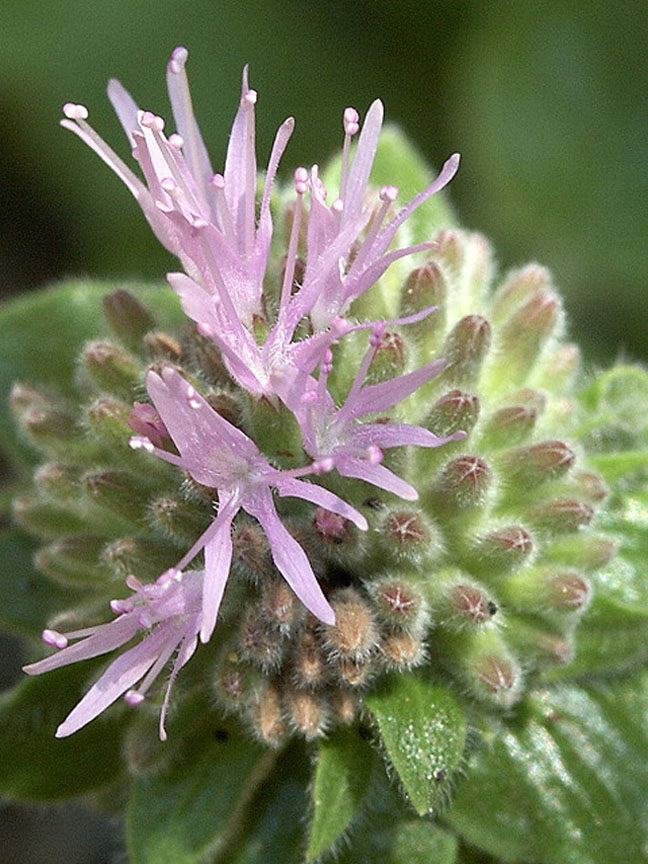
© Copyright 2009, by Wildergarten Press, All Rights Reserved